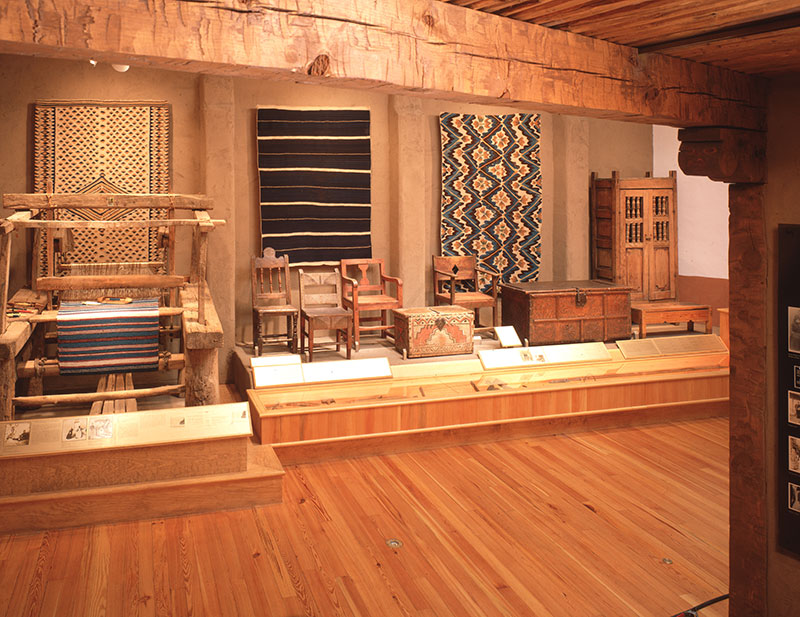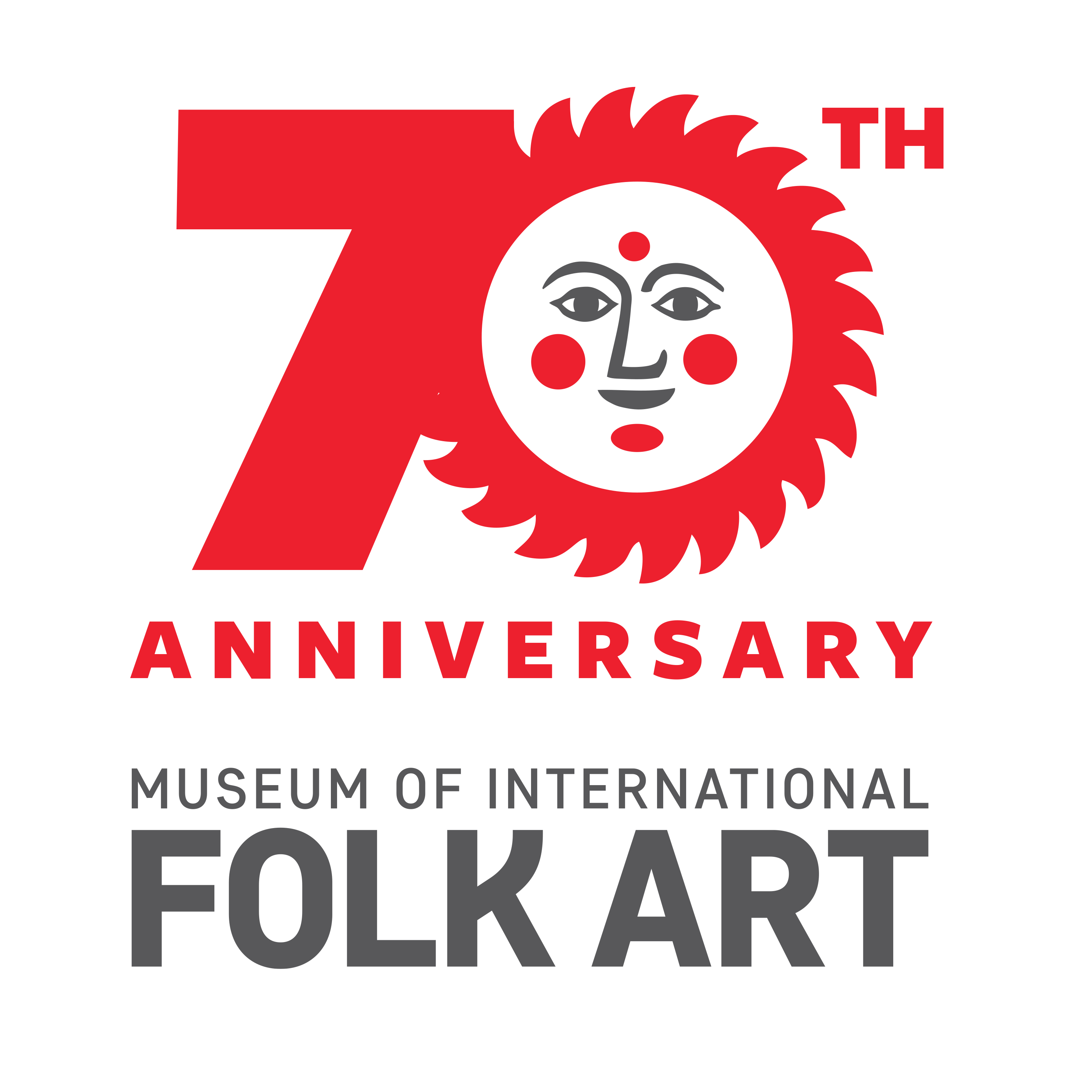Museum of International Folk Art Celebrates 70 Years
Since its founding in 1953, the Museum of International Folk Art has been a place to connect people through creative expression and cross-cultural understanding. Each visitor is reminded of this legacy by the words of its founder, Florence Dibell Bartlett (1881-1953), that are installed above the museum’s entrance:
“The art of the craftsman is a bond between the peoples of the world.”
Opening of the Museum
Museum of International Folk Art opened to great international fanfare on September 5, 1953, following years of dedicated work by its founder. Florence Bartlett was born in Chicago to a family steeped in the arts with a passion for the handmade. Her desire to preserve folk art was enhanced through her global travels as she assembled a collection of remarkable quality and breadth. With an unwavering love of New Mexico, she hired the celebrated architect John Gaw Meem (1894-1983) to design a modern museum to showcase her vast collection in Santa Fe, gifting her entire collection to the citizens of the state.

Florence Dibell Bartlett at Museum of International Folk Art on opening day, September 5, 1953. Neg. no. 1469 (detail), MOIFA General Image Collection (AR.00009.3).
Girard Foundation Collection and the Creation of Multiple Visions
In 1972, the museum approached the designer Alexander Girard (1907-1993) and his wife Susan (1910-1996) about gifting their celebrated Girard Foundation Collection. Established in 1960, the Girard Foundation had amassed a collection of more than 106,000 folk art objects from around the world. Following a funding commitment from the State of New Mexico for museum expansion, the gift was made official in 1978. Known for his vibrant textiles and interiors, Girard painstakingly designed and installed Multiple Visions using modern sensibilities to create a unique exhibition space that first opened to the public in 1982.

Alexander Girard at work during the Fantasy and Enchantment installation, 1977. (Photo: Art Taylor/MNM). MOIFA Exhibitions (AR00004.164).
Hispanic Heritage Wing
The 1970s and 1980s saw the development of Spanish Colonial Art as a field of study, including groundbreaking exhibitions of New Mexico’s folk art traditions that provided opportunities for the museum to collaborate with local communities. This new specialization brought about another expansion of dedicated exhibition space with the new Hispanic Heritage Wing in 1989. The inaugural exhibition, Familia y Fe, was co-curated by Helen Lucero, the museum’s first Curator of New Mexican Crafts and Textiles.

Familia y Fe, Hispanic Heritage Wing inaugural exhibit, installation view, 1989. (Photo: Michel Monteaux/ MNM). MOIFA Exhibitions (AR.00004.186).
Neutrogena and Lloyd Cotsen’s Gift
In 1995, the Museum pursued a renowned collection that embodied the vision of collector Lloyd Cotsen (1929-2017), CEO of Neutrogena Corporation. He had acquired more than 3,000 textiles, ceramics, woodcarvings, and metalwork with the purpose of finding “the extraordinary in the ordinary.” This gift not only included an important collection of folk art, but also resulted in a major expansion that was made up of nearly 9,000 square feet of additional exhibition space, dedicated storage, and an area for interactive exhibitions and participatory engagement called “Lloyd’s Treasure Chest.” First opened to the public in 1998, this expansion also included an open layout design that allowed visitors to see behind-the-scenes into collections storage.

Bear Wall (A.1995.93.2421V), carved red cedar doors by Marvin Oliver (Quinault/Isleta), installed at the north entrance to the Neutrogena Wing lobby. MOIFA Exhibitions (AR.00004.212).
Mark Naylor and Dale Gunn Gallery of Conscience
The Mark Naylor and Dale Gunn Gallery of Conscience was launched in 2010 in response to the idea that folk art was a catalyst to understanding and addressing larger social issues. The first exhibition, Empowering Women, was produced in collaboration with members of women’s cooperatives featured at that year’s International Folk Art Market. Since then, it has explored pressing issues such as Japanese American internment camps, shifting immigration policies, and the world’s responses to the Covid pandemic. The Gallery of Conscience is celebrated as a space that promotes visitor engagement and dialogue, community involvement, collaboration, and experimentation.

#mask: Creative Responses to the Global Pandemic, the Gallery of Conscience installation view, 2021. (Photo: MNM). MOIFA Exhibits (AR.00004.284).
Groundbreaking Exhibitions, Fieldwork, and Publications
Now one of the world's largest folk art museums, Museum of International Folk Art has long utilized its collections, professional expertise of staff, visiting artists, and other resources to further the study and understanding of evolving folk traditions. Museum publications have ranged in size and subject matter, spanning diverse world cultures through a variety of media. The museum’s projects draw upon personal stories, community traditions, fieldwork, consultants, and archival research to produce award-winning exhibitions and education programs, many of which travel throughout the state and to cultural institutions across the country.

Crafting Memory: The Art of Community in Peru exhibition installation view, 2018. (Photo: Blair Clark/MNM). MOIFA Exhibitions (AR.00004.273).
Education and Outreach
Museum of International Folk Art has always been on the forefront of developing innovative approaches to hands-on and interactive learning. Programs include “Folk Art to Go,” school partnerships, artist demonstrations, lectures, performances, interactive gallery experiences, and music and film presentations. Online lectures and docent tours have also contributed to an institution dedicated to reaching new and diverse audiences.

Support the Museum
The ongoing success of Museum of International Folk Art relies on dedicated staff, docents and volunteers, as well as supporters and donors who believe in its mission and the legacy set forth by its founder, who generously established the International Folk Art Foundation in 1951 to support the mission of the museum.
Museum of New Mexico Foundation was established in 1962 to seek private support to advance the museum through donations and legacy gifts with the help of Friends of Folk Art. Museum of International Folk Art is a division of New Mexico Department of Cultural Affairs, with additional oversight by Museum of New Mexico Board of Regents.
You can support the Museum's legacy by making a tax-deductible donation today. Your generosity will sustain world-class exhibitions and extensive educational programs and promote understanding of global folk art for generations to come.
We are grateful to the following:
- Friends of Folk Art
- Edward and Maria Gale, the Gale Family Foundation
- International Folk Art Foundation
- Museum of New Mexico Foundation

Michael and Laurie Vander Velde, Folk Art Flea sponsors, 2022. Photo courtesy of Frank Chambers.

